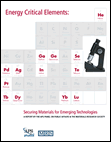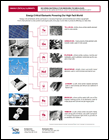February 18, 2011
New APS-MRS Report: Energy Critical Elements—Developing New Technologies to Foster U.S. Energy Independence
Consistent with the report’s recommendations, U.S. senator introduces bill to develop sustainable ECE supply
WASHINGTON, D.C. — As China announces its intention to slash exports of rare earth elements, a new report, Energy Critical Elements: Securing Materials for Emerging Technologies, released by the American Physical Society (APS) and Materials Research Society (MRS), describes a plan to secure future supplies of rare earths and other elements critical to the development of new technologies to foster U.S energy independence.
Energy-Critical Elements (ECEs) are chemical elements that have the capacity to transform the way we capture, transmit, store or conserve energy. In addition to rare earth elements, ECEs potentially include more than a dozen others, such as indium, lithium and tellurium – used in electric cars, wind turbines and solar cells.
“Our report outlines a plan that can help the U.S. take control of its energy future,” said Robert Jaffe, Morningstar Professor of Physics at Massachusetts Institute of Technology and co-chair of the APS-MRS study group. “No country can mine its way to ECE independence. Instead, we need to develop an integrated approach to securing supplies of these key materials.”
The report cautions against stockpiling the elements, pointing out that the method is a disincentive to innovation. Instead, it calls for stabilizing ECE supplies using a multi-faceted approach that includes substitutional research, enhanced recycling and gathering, and disseminating accurate information about ECE availability. Using these approaches, General Electric successfully redesigned its high performance turbines while anticipating a shortage of rhenium, an ECE, according to the report.
A bill introduced by U.S. Sen. Mark Udall, of Colorado, the “Critical Minerals and Materials Promotion Act of 2011,” makes similar recommendations to those found in the report.
“It’s vital that we take steps today that will stabilize the market for energy-critical materials and ensure we have a sustainable supply in the future,” Udall said. “The APS-MRS report and my bill provide a solid foundation that, when implemented, will help U.S. companies globally compete in emerging energy industries that are essential to strengthening U.S. economic and national security.”
Elements can be deemed “energy-critical” for various reasons. Some are simply rare in the Earth’s crust or poorly concentrated by geological processes. Others occur only in a few mines worldwide, or production might be dominated by, and therefore subject to, manipulation by one or more countries. The United States relies on other countries for more than 90 percent of most of the ECEs identified in the report. China produces 95 percent of all rare earth elements and recently announced plans to cut its exports of the minerals to various nations by 35 percent. Many ECEs have been produced as by-products of primary metals refining, complicating attempts to produce large quantities. Because they are relatively scarce, extraction of ECEs often involves processing large amounts of material, sometimes in ways that do unacceptable environmental damage.
To deal with the multifaceted issue of ECE availability, the APS/MRS makes several recommendations, including the following:
Information Collection and Analysis
- The U.S. government should gather, analyze and disseminate information on energy-critical elements across the lifecycle supply chain, including discovered and potential resources, production, use, trade, disposal and recycling.
- The federal government should regularly survey emerging technologies and the supply chain for elements throughout the periodic table with the aim of identifying critical applications, as well as potential shortfalls.
- The entity undertaking this task should be a Principal Statistical Agency, a designation that would enable it to require compliance with requests for information.
- Comprehensive, reliable and up-to-date information on all aspects of the lifecycle of ECEs would enable researchers, developers and investors to plan more successfully for the materials needs of new technologies.
Research and Development
- The federal government should establish a research and development effort focused on energy-critical elements and possible substitutes that can enhance vital aspects of the supply chain, including: geological deposit modeling, mineral extraction and processing, material characterization and substitution, utilization, manufacturing, recycling and lifecycle analysis. Such an effort would also address critical, but manageable, workforce needs.
Materials Efficiency
- The federal government should establish a consumer-oriented “Critical Materials” designation for ECE-related products. At the same time, steps should be taken to improve rates of post-consumer collection of industrial and consumer products containing ECEs, beginning with an examination of the numerous methods being explored and implemented in various states and countries.
Market Interventions
- The study committee does not recommend that the federal government establish non-defense-related economic stockpiles of ECEs with the exception of one element: helium. It is unique among energy-critical elements because helium is permanently lost to the atmosphere if it is not captured during natural gas extraction. Measures should be adopted that will both conserve and enhance the nation’s helium reserves.
About MRS
Founded in 1973, MRS (www.mrs.org) now consists of over 15,100 members from the United States—as well as nearly 70 other countries. The Society is different from that of single discipline professional societies because it encourages communication and technical information exchange across the various fields of science affecting materials. MRS sponsors two major annual meetings, offering approximately 75 topical symposia. The Society recognizes professional and technical excellence, conducts symposium tutorials, and encourages technical interaction among college students through university chapters and among materials professionals through regional sections.
Critical Elements Report
The Energy Critical Elements: Securing Materials for Emerging Technologies is 28 pages (1.4MB).

![]()
Critical Elements Fact Sheet
The one page Energy Critical Elements Fact Sheet explains how these critical elements power our high-tech world.

![]()

![]()
About APS
The American Physical Society is a nonprofit membership organization working to advance and diffuse the knowledge of physics through its outstanding research journals, scientific meetings, and education, outreach, advocacy, and international activities. APS represents more than 50,000 members, including physicists in academia, national laboratories, and industry in the United States and throughout the world.


